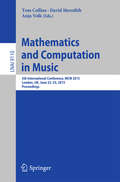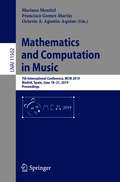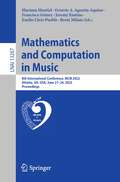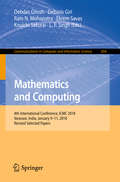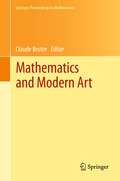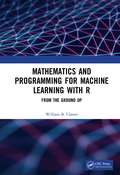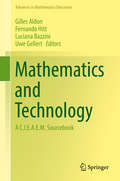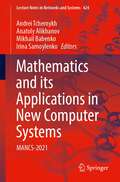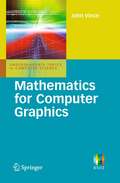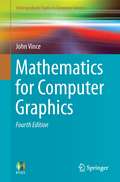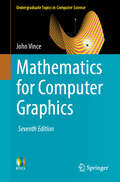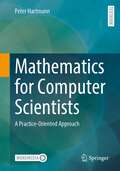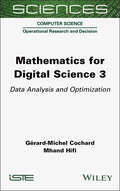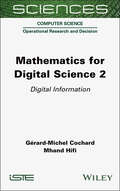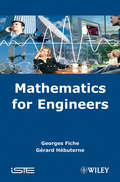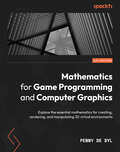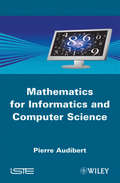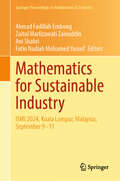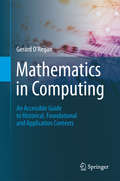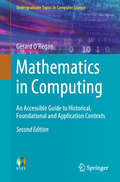- Table View
- List View
Mathematics and Computation in Music
by David Meredith Tom Collins Anja VolkThis book constitutes the thoroughly refereed proceedings of the 5th International Conference on Mathematics and Computation in Music, MCM 2015, held in London, UK, in June 2015. The 24 full papers and 14 short papers presented were carefully reviewed and selected from 64 submissions. The papers feature research that combines mathematics or computation with music theory, music analysis, composition, and performance. They are organized in topical sections on notation and representation, music generation, patterns, performance, similarity and contrast, post-tonal music analysis, geometric approaches, deep learning, and scales.
Mathematics and Computation in Music: 7th International Conference, MCM 2019, Madrid, Spain, June 18–21, 2019, Proceedings (Lecture Notes in Computer Science #11502)
by Octavio A. Agustín-Aquino Mariana Montiel Francisco Gomez-MartinThis book constitutes the thoroughly refereed proceedings of the 7th International Conference on Mathematics and Computation in Music, MCM 2019, held in Madrid, Spain, in June 2019. The 22 full papers and 10 short papers presented were carefully reviewed and selected from 48 submissions. The papers feature research that combines mathematics or computation with music theory, music analysis, composition, and performance. They are organized in topical sections on algebraic and other abstract mathematical approaches to understanding musical objects; remanaging Riemann: mathematical music theory as “experimental philosophy”?; octave division; computer-based approaches to composition and score structuring; models for music cognition and beat tracking; pedagogy of mathematical music theory.The chapter “Distant Neighbors and Interscalar Contiguities” is available open access under a Creative Commons Attribution 4.0 International License via link.springer.com.
Mathematics and Computation in Music: 8th International Conference, MCM 2022, Atlanta, GA, USA, June 21–24, 2022, Proceedings (Lecture Notes in Computer Science #13267)
by Octavio A. Agustín-Aquino Emilio Lluis-Puebla Mariana Montiel Francisco Gómez Jeremy Kastine Brent MilamThis book constitutes the thoroughly refereed proceedings of the 8th International Conference on Mathematics and Computation in Music, MCM 2022, held in Atlanta, GA, USA, in June 2022. The 29 full papers and 8 short papers presented were carefully reviewed and selected from 45 submissions. The papers feature research that combines mathematics or computation with music theory, music analysis, composition, and performance. They are organized in Mathematical Scale and Rhythm Theory: Combinatorial, Graph Theoretic, Group Theoretic and Transformational Approaches; Categorical and Algebraic Approaches to Music; Algorithms and Modeling for Music and Music-Related Phenomena; Applications of Mathematics to Musical Analysis; Mathematical Techniques and Microtonality
Mathematics and Computation in Music: 9th International Conference, MCM 2024, Coimbra, Portugal, June 18–21, 2024, Proceedings (Lecture Notes in Computer Science #14639)
by Thomas Noll Mariana Montiel Francisco Gómez Omar Costa Hamido José Luis Besada José Oliveira MartinsThis book constitutes the refereed proceedings of the 9th International Conference on Mathematics and Computation in Music, MCM 2024, held in Coimbra, Portugal, during June 18–21, 2024. The 30 full papers and 9 short papers included in this book were carefully reviewed and selected from 45 submissions. They were organized in topical sections as follows: mathematical scale theory and tuning; rhythm analysis and rhythm generation; categorical and algebraic approaches to music; quantum music; theory and algorithms for melodic- harmonic analysis and generation; geometric approaches to musical algorithms and microtonality; fourier analysis for music; similarity and distance measures for music; short papers; communication-performances; and tribute to Yves Hellegouarch.
Mathematics and Computing: Icmc, Haldia, India, January 2015 (Springer Proceedings In Mathematics And Statistics Series #139)
by Ram N. Mohapatra Debasis Giri Debdas Ghosh Ekrem Savas Kouichi Sakurai L. P. SinghThis book constitutes the proceedings of the 4th International Conference on Mathematics and Computing, ICMC 2018, held in Varanasi, India, in January 2018.The 29 papers presented in this volume were carefully reviewed and selected from 116 submissions. They are organized in topical sections on security and coding theory; computing; applied mathematics; pure mathematics.
Mathematics and Logics in Computer Science: Proceedings of ICMLCS 2024 (Algorithms for Intelligent Systems)
by Bimal Kumar Roy Atul Chaturvedi Boaz TsabanThis book presents high-quality research papers presented at International Conference on Mathematics and Logics in Computer Science (ICMLCS 2024) held at Allenhouse Institute of Technology, Kanpur, India, during August 30–31, 2024. The book covers recent research in data science, network security, theory of computing, network security, cloud computing, coding theory, linear algebra and its applications in machine learning, artificial intelligence, block chain, deep learning, graph theory, cryptography, cyber security, internet of things, quantum computing, and steganography.
Mathematics and Modern Art
by Claude BruterThe link between mathematics and art remains as strong today as it was in the earliest instances of decorative and ritual art. Arts, architecture, music and painting have for a long time been sources of new developments in mathematics, and vice versa. Many great painters have seen no contradiction between artistic and mathematical endeavors, contributing to the progress of both, using mathematical principles to guide their visual creativity, enriching their visual environment with the new objects created by the mathematical science. Owing to the recent development of the so nice techniques for visualization, while mathematicians can better explore these new mathematical objects, artists can use them to emphasize their intrinsic beauty, and create quite new sceneries. This volume, the content of the first conference of the European Society for Mathematics and the Arts (ESMA), held in Paris in 2010, gives an overview on some significant and beautiful recent works where maths and art, including architecture and music, are interwoven. The book includes a wealth of mathematical illustrations from several basic mathematical fields including classical geometry, topology, differential geometry, dynamical systems. Here, artists and mathematicians alike elucidate the thought processes and the tools used to create their work
Mathematics and R Programming for Machine Learning: From the Ground Up
by William B. ClasterBased on the author’s experience in teaching data science for more than 10 years, Mathematics and Programming for Machine Learning with R: From the Ground Up reveals how machine learning algorithms do their magic and explains how these algorithms can be implemented in code. It is designed to provide readers with an understanding of the reasoning behind machine learning algorithms as well as how to program them. Written for novice programmers, the book progresses step-by-step, providing the coding skills needed to implement machine learning algorithms in R. The book begins with simple implementations and fundamental concepts of logic, sets, and probability before moving to the coverage of powerful deep learning algorithms. The first eight chapters deal with probability-based machine learning algorithms, and the last eight chapters deal with machine learning based on artificial neural networks. The first half of the book does not require mathematical sophistication, although familiarity with probability and statistics would be helpful. The second half assumes the reader is familiar with at least one semester of calculus. The text guides novice R programmers through algorithms and their application and along the way; the reader gains programming confidence in tackling advanced R programming challenges. Highlights of the book include: More than 400 exercises A strong emphasis on improving programming skills and guiding beginners to the implementation of full-fledged algorithms Coverage of fundamental computer and mathematical concepts including logic, sets, and probability In-depth explanations of machine learning algorithms
Mathematics and Technology
by Uwe Gellert Gilles Aldon Fernando Hitt Luciana BazziniThis volume collects most recent work on the role of technology in mathematics education. It offers fresh insight and understanding of the many ways in which technological resources can improve the teaching and learning of mathematics. The first section of the volume focuses on the question how a proposed mathematical task in a technological environment can influence the acquisition of knowledge and what elements are important to retain in the design of mathematical tasks in computing environments. The use of white smart boards, platforms as Moodle, tablets and smartphones have transformed the way we communicate both inside and outside the mathematics classroom. Therefore the second section discussed how to make efficient use of these resources in the classroom and beyond. The third section addresses how technology modifies the way information is transmitted and how mathematical education has to take into account the new ways of learning through connected networks as well as new ways of teaching. The last section is on the training of teachers in the digital era. The editors of this volume have selected papers from the proceedings of the 65th, 66th and 67th CIEAEM conference, and invited the correspondent authors to contribute to this volume by discussing one of the four important topics. The book continues a series of sourcebooks edited by CIEAEM, the Commission Internationale pour l'#65533;tude et l'Am#65533;lioration de l'Enseignement des Math#65533;matiques / International Commission for the Study and Improvement of Mathematics Education.
Mathematics and its Applications in New Computer Systems: MANCS-2021 (Lecture Notes in Networks and Systems #424)
by Andrei Tchernykh Irina Samoylenko Anatoly Alikhanov Mikhail BabenkoThis book is based on the best papers accepted for presentation during the International Conference on Mathematics and its Applications in New Computer Systems (MANCS-2021), Russia.The book includes research materials on modern mathematical problems, solutions in the field of cryptography, data analysis and modular computing, as well as scientific computing. The scope of numerical methods in scientific computing presents original research, including mathematical models and software implementations, related to the following topics: numerical methods in scientific computing; solving optimization problems; methods for approximating functions, etc. The studies in mathematical solutions to cryptography issues are devoted to secret sharing schemes, public key systems, private key systems, n-degree comparisons, modular arithmetic of simple, addition of points of an elliptic curve, Hasse theorem, homomorphic encryption and learning with error, and modifications of the RSA system. Furthermore, issues in data analysis and modular computing include contributions in the field of mathematical statistics, machine learning methods, deep learning, and neural networks. Finally, the book gives insights into the fundamental problems in mathematics education. The book intends for readership specializing in the field of cryptography, information security, parallel computing, computer technology, and mathematical education.
Mathematics for Computer Graphics
by John A. VinceJohn Vince explains a wide range of mathematical techniques and problem-solving strategies associated with computer games, computer animation, virtual reality, CAD, and other areas of computer graphics. Covering all the mathematical techniques required to resolve geometric problems and design computer programs for computer graphic applications, each chapter explores a specific mathematical topic prior to moving forward into the more advanced areas of matrix transforms, 3D curves and surface patches. Problem-solving techniques using vector analysis and geometric algebra are also discussed. All the key areas are covered including: Numbers, Algebra, Trigonometry, Coordinate geometry, Transforms, Vectors, Curves and surfaces, Barycentric coordinates, Analytic geometry. Plus - and unusually in a student textbook - a chapter on geometric algebra is included.
Mathematics for Computer Graphics
by John VinceJohn Vince explains a wide range of mathematical techniques and problem-solving strategies associated with computer games, computer animation, virtual reality, CAD and other areas of computer graphics in this updated and expanded fourth edition. The first four chapters revise number sets, algebra, trigonometry and coordinate systems, which are employed in the following chapters on vectors, transforms, interpolation, 3D curves and patches, analytic geometry and barycentric coordinates. Following this, the reader is introduced to the relatively new topic of geometric algebra, and the last two chapters provide an introduction to differential and integral calculus, with an emphasis on geometry. Mathematics for Computer Graphics covers all of the key areas of the subject, including: Number sets Algebra Trigonometry Coordinate systems Transforms Quaternions Interpolation Curves and surfaces Analytic geometry Barycentric coordinates Geometric algebra Differential calculus Integral calculus This fourth edition contains over 120 worked examples and over 270 illustrations, which are central to the author's descriptive writing style. Mathematics for Computer Graphics provides a sound understanding of the mathematics required for computer graphics, giving a fascinating insight into the design of computer graphics software and setting the scene for further reading of more advanced books and technical research papers.
Mathematics for Computer Graphics
by John VinceJohn Vince explains a wide range of mathematical techniques and problem-solving strategies associated with computer games, computer animation, virtual reality, CAD and other areas of computer graphics in this completely revised and expanded fifth edition. The first five chapters cover a general introduction, number sets, algebra, trigonometry and coordinate systems, which are employed in the following chapters on vectors, matrix algebra, transforms, interpolation, curves and patches, analytic geometry and barycentric coordinates. Following this, the reader is introduced to the relatively new topic of geometric algebra, followed by two chapters that introduce differential and integral calculus. Finally, there is a chapter on worked examples. Mathematics for Computer Graphics covers all of the key areas of the subject, including: #65533; Number sets #65533; Algebra #65533; Trigonometry #65533; Coordinate systems #65533; Determinants#65533; Vectors #65533; Quaternions #65533; Matrix algebra #65533; Geometric transforms #65533; Interpolation #65533; Curves and surfaces #65533; Analytic geometry #65533; Barycentric coordinates #65533; Geometric algebra #65533; Differential calculus #65533; Integral calculus This fifth edition contains over 120 worked examples and over 320 colour illustrations, which are central to the author's descriptive writing style. Mathematics for Computer Graphics provides a sound understanding of the mathematics required for computer graphics, giving a fascinating insight into the design of computer graphics software and setting the scene for further reading of more advanced books and technical research papers.
Mathematics for Computer Graphics (Undergraduate Topics in Computer Science)
by John VinceJohn Vince explains a comprehensive range of mathematical techniques and problem-solving strategies associated with computer games, computer animation, special effects, virtual reality, CAD and other areas of computer graphics in this completely revised and expanded seventh edition. The first five chapters cover a general introduction, number sets, algebra, trigonometry and coordinate systems, which are employed in the following chapters on determinants, vectors, matrix algebra, complex numbers, geometric transforms, quaternion algebra, quaternions in space, interpolation, statistics, curves and patches, analytical geometry and barycentric coordinates. Following this, the reader is introduced to the relatively new subject of geometric algebra, followed by two chapters that introduce differential and integral calculus. Finally, there are chapters on Fourier analysis and Worked examples. Mathematics for Computer Graphics covers all of the key areas of the subject, including: • Number sets • Algebra • Trigonometry • Complex numbers • Coordinate systems • Determinants • Vectors • Quaternions • Matrix algebra • Geometric transforms • Interpolation • Curves and surfaces • Analytic geometry • Statistics • Barycentric coordinates • Geometric algebra • Differential calculus • Integral calculus • Fourier analysis This seventh edition contains approximately 200 worked examples and over 350 colour illustrations, which are central to the author’s descriptive writing style. Mathematics for Computer Graphics provides a sound understanding of the mathematics required for computer graphics software and setting the scene for further reading of more advanced books and technical research papers.
Mathematics for Computer Scientists: A Practice-Oriented Approach
by Peter HartmannThis textbook contains the mathematics needed to study computer science in application-oriented computer science courses. The content is based on the author's many years of teaching experience.The translation of the original German 7th edition Mathematik für Informatiker by Peter Hartmann was done with the help of artificial intelligence. A subsequent human revision was done primarily in terms of content.Textbook FeaturesYou will always find applications to computer science in this book.Not only will you learn mathematical methods, you will gain insights into the ways of mathematical thinking to form a foundation for understanding computer science.Proofs are given when they help you learn something, not for the sake of proving.Mathematics is initially a necessary evil for many students. The author explains in each lesson how students can apply what they have learned by giving many real world examples, and by constantly cross-referencing math and computer science. Students will see how math is not only useful, but can be interesting and sometimes fun.The ContentSets, logic, number theory, algebraic structures, cryptography, vector spaces, matrices, linear equations and mappings, eigenvalues, graph theory.Sequences and series, continuous functions, differential and integral calculus, differential equations, numerics.Probability theory and statistics.The Target AudiencesStudents in all computer science-related coursework, and independent learners.
Mathematics for Digital Science 3: Data Analysis and Optimization (ISTE Invoiced)
by Mhand Hifi Gérard-Michel CochardOver the past century, advancements in computer science have consistently resulted from extensive mathematical work. Even today, innovations in the digital domain continue to be grounded in a strong mathematical foundation. To succeed in this profession, both today's students and tomorrow’s computer engineers need a solid mathematical background. The goal of this book series is to offer a solid foundation of the knowledge essential to working in the digital sector. Across three volumes, it explores fundamental principles, digital information, data analysis, and optimization. Whether the reader is pursuing initial training or looking to deepen their expertise, the Mathematics for Digital Science series revisits familiar concepts, helping them refresh and expand their knowledge while also introducing equally essential, newer topics.
Mathematics for Digital Science, Volume 1: Fundamentals (ISTE Consignment)
by Gerard-Michel Cochard Mhand HifiOver the past century, advancements in computer science have consistently resulted from extensive mathematical work. Even today, innovations in the digital domain continue to be grounded in a strong mathematical foundation. To succeed in this profession, both today's students and tomorrow’s computer engineers need a solid mathematical background. The goal of this book series is to offer a solid foundation of the knowledge essential to working in the digital sector. Across three volumes, it explores fundamental principles, digital information, data analysis, and optimization. Whether the reader is pursuing initial training or looking to deepen their expertise, the Mathematics for Digital Science series revisits familiar concepts, helping them refresh and expand their knowledge while also introducing equally essential, newer topics.
Mathematics for Digital Science, Volume 2: Digital Information (ISTE Invoiced)
by Mhand Hifi Gérard-Michel CochardOver the past century, advancements in computer science have consistently resulted from extensive mathematical work. Even today, innovations in the digital domain continue to be grounded in a strong mathematical foundation. To succeed in this profession, both today’s students and tomorrow’s computer engineers need a solid mathematical background. The goal of this book series is to offer a solid foundation of the knowledge essential to working in the digital sector. Across three volumes, it explores fundamental principles, digital information, data analysis, and optimization. Whether the reader is pursuing initial training or looking to deepen their expertise, the Mathematics for Digital Science series revisits familiar concepts, helping them refresh and expand their knowledge while also introducing equally essential, newer topics.
Mathematics for Economists with Applications
by James BerginMathematics for Economists with Applications provides detailed coverage of the mathematical techniques essential for undergraduate and introductory graduate work in economics, business and finance. Beginning with linear algebra and matrix theory, the book develops the techniques of univariate and multivariate calculus used in economics, proceeding to discuss the theory of optimization in detail. Integration, differential and difference equations are considered in subsequent chapters. Uniquely, the book also features a discussion of statistics and probability, including a study of the key distributions and their role in hypothesis testing. Throughout the text, large numbers of new and insightful examples and an extensive use of graphs explain and motivate the material. Each chapter develops from an elementary level and builds to more advanced topics, providing logical progression for the student, and enabling instructors to prescribe material to the required level of the course. With coverage substantial in depth as well as breadth, and including a companion website at www.routledge.com/cw/bergin, containing exercises related to the worked examples from each chapter of the book, Mathematics for Economists with Applications contains everything needed to understand and apply the mathematical methods and practices fundamental to the study of economics.
Mathematics for Engineers
by Gerard Hebuterne Georges FicheThis book offers comprehensive coverage of all the mathematical tools needed by engineers in the field of processing and transport of all forms of information, data and images - as well as many other engineering disciplines. It provides essential theories, equations and results in probability theory and statistics, which constitute the basis for the presentation of signal processing,information theory, traffic and queueing theory, and reliability. The mathematical foundations of simulation are also covered. The book's accessible style will enable students, engineers and researches new to this area to advance their knowledge of communication and other engineering technologies; however, it will also serve as a useful reference guide to anyone wishing to further explore this field.
Mathematics for Game Programming and Computer Graphics: Explore the essential mathematics for creating, rendering, and manipulating 3D virtual environments
by Penny de BylA comprehensive guide to learning fundamental 3D mathematical principles used in games and computer graphics by exampleKey FeaturesGet acquainted with the essential mathematics needed to describe, simulate, and render 3D creationsConstruct and manipulate 3D animated environments using Python, Pygame, and PyOpenGLDevelop vertex and fragment shaders in OpenGL shader language to speed up renderingBook DescriptionMathematics is an essential skill when it comes to graphics and game development, particularly if you want to understand the generation of real-time computer graphics and the manipulation of objects and environments in a detailed way. Python, together with Pygame and PyOpenGL, provides you with the opportunity to explore these features under the hood, revealing how computers generate and manipulate 3D environments.Mathematics for Game Programming and Computer Graphics is an exhaustive guide to getting “back to the basics” of mathematics, using a series of problem-based, practical exercises to explore ideas around drawing graphic lines and shapes, applying vectors and vertices, constructing and rendering meshes, and working with vertex shaders. By leveraging Python, Pygame, and PyOpenGL, you'll be able to create your own mathematics-based engine and API that will be used throughout to build applications.By the end of this graphics focussed book, you'll have gained a thorough understanding of how essential mathematics is for creating, rendering, and manipulating 3D virtual environments and know the secrets behind today's top graphics and game engines.What you will learnGet up and running with Python, Pycharm, Pygame, and PyOpenGLExperiment with different graphics API drawing commandsReview basic trigonometry and how it's important in 3D environmentsApply vectors and matrices to move, orient, and scale 3D objectsRender 3D objects with textures, colors, shading, and lightingWork with vertex shaders for faster GPU-based renderingWho this book is forThis book is for programmers who want to enhance their 3D mathematics skills relating to computer graphics and computer games. Knowledge of high school–level mathematics and a working understanding in an object-orientated language is needed to grasp the contents present in this book.
Mathematics for Informatics and Computer Science
by Pierre AudibertHow many ways do exist to mix different ingredients, how many chances to win a gambling game, how many possible paths going from one place to another in a network ? To this kind of questions Mathematics applied to computer gives a stimulating and exhaustive answer. This text, presented in three parts (Combinatorics, Probability, Graphs) addresses all those who wish to acquire basic or advanced knowledge in combinatorial theories. It is actually also used as a textbook. Basic and advanced theoretical elements are presented through simple applications like the Sudoku game, search engine algorithm and other easy to grasp applications. Through the progression from simple to complex, the teacher acquires knowledge of the state of the art of combinatorial theory. The non conventional simultaneous presentation of algorithms, programs and theory permits a powerful mixture of theory and practice. All in all, the originality of this approach gives a refreshing view on combinatorial theory.
Mathematics for Sustainable Industry: ISMI 2024, Kuala Lumpur, Malaysia, September 9–11 (Springer Proceedings in Mathematics & Statistics #496)
by Ahmad Fadillah Embong Zaitul Marlizawati Zainuddin Ani Shabri Fatin Nadiah Mohamed YussofThis volume gathers selected, peer-reviewed contributions presented at the 5th International Seminar on Mathematics in Industry – ISMI2024, held on September 9-11, 2024 in Kuala Lumpur, Malaysia. Articles in this volume touch on fields such as applied mathematics, applied probability theory and stochastic modeling, statistical modeling, operations research, biomathematics, optimization, inventory management, supply chain, and computational mathematics, all with an emphasis on solutions to real-world problems. Many of the studies contained here closely relate to the United Nations&’ Sustainable Development Goals, namely SDG 9 (Industry) and SDG 3 (Health), potentially inspiring practitioners and scholars to deploy these findings and pursue similar avenues of research. Since its inception in 2013, ISMI has been organized by the Centre for Industrial and Applied Mathematics (UTM-CIAM) and the Department of Mathematical Sciences, Universiti Teknologi Malaysia (UTM) with the aims of disseminating knowledge, sharing experiences in research on various aspects of industrial mathematics and statistics and fostering collaboration among academia, government agencies, industry, and community.
Mathematics in Computing
by Gerard O’reganThis clearly written and enlightening textbook provides a concise, introductory guide to the key mathematical concepts and techniques used by computer scientists. Topics and features: ideal for self-study, offering many pedagogical features such as chapter-opening key topics, chapter introductions and summaries, review questions, and a glossary; places our current state of knowledge within the context of the contributions made by early civilizations, such as the ancient Babylonians, Egyptians and Greeks; examines the building blocks of mathematics, including sets, relations and functions; presents an introduction to logic, formal methods and software engineering; explains the fundamentals of number theory, and its application in cryptography; describes the basics of coding theory, language theory, and graph theory; discusses the concept of computability and decideability; includes concise coverage of calculus, probability and statistics, matrices, complex numbers and quaternions.
Mathematics in Computing: An Accessible Guide to Historical, Foundational and Application Contexts (Undergraduate Topics in Computer Science)
by Gerard O’ReganThis illuminating textbook provides a concise review of the core concepts in mathematics essential to computer scientists. Emphasis is placed on the practical computing applications enabled by seemingly abstract mathematical ideas, presented within their historical context. The text spans a broad selection of key topics, ranging from the use of finite field theory to correct code and the role of number theory in cryptography, to the value of graph theory when modelling networks and the importance of formal methods for safety critical systems.This fully updated new edition has been expanded with a more comprehensive treatment of algorithms, logic, automata theory, model checking, software reliability and dependability, algebra, sequences and series, and mathematical induction.Topics and features: includes numerous pedagogical features, such as chapter-opening key topics, chapter introductions and summaries, review questions, and a glossary; describes the historical contributions of such prominent figures as Leibniz, Babbage, Boole, and von Neumann; introduces the fundamental mathematical concepts of sets, relations and functions, along with the basics of number theory, algebra, algorithms, and matrices; explores arithmetic and geometric sequences and series, mathematical induction and recursion, graph theory, computability and decidability, and automata theory; reviews the core issues of coding theory, language theory, software engineering, and software reliability, as well as formal methods and model checking; covers key topics on logic, from ancient Greek contributions to modern applications in AI, and discusses the nature of mathematical proof and theorem proving; presents a short introduction to probability and statistics, complex numbers and quaternions, and calculus.This engaging and easy-to-understand book will appeal to students of computer science wishing for an overview of the mathematics used in computing, and to mathematicians curious about how their subject is applied in the field of computer science. The book will also capture the interest of the motivated general reader.
